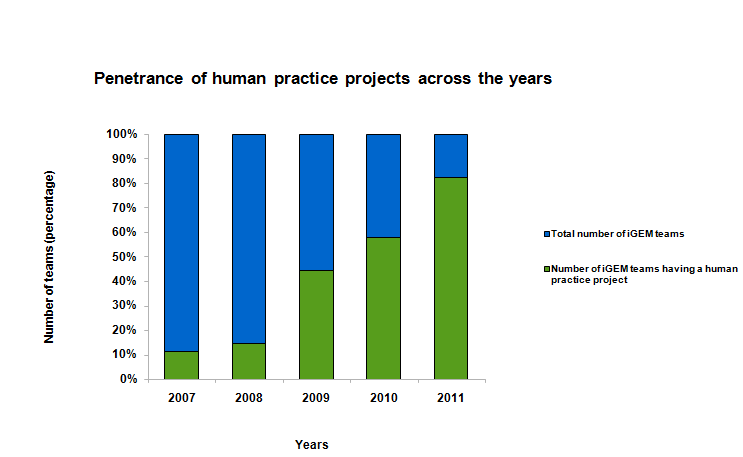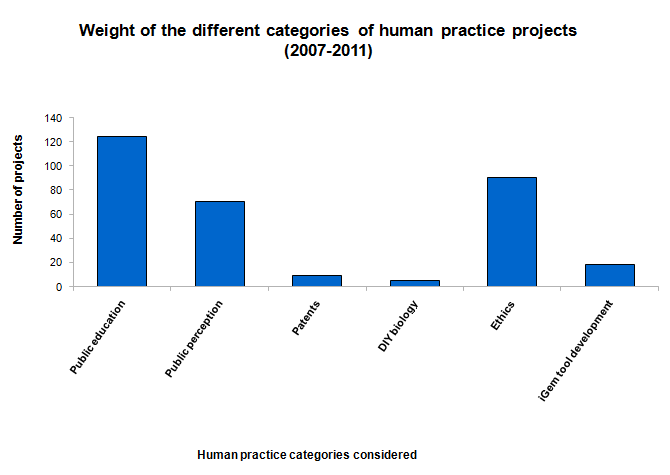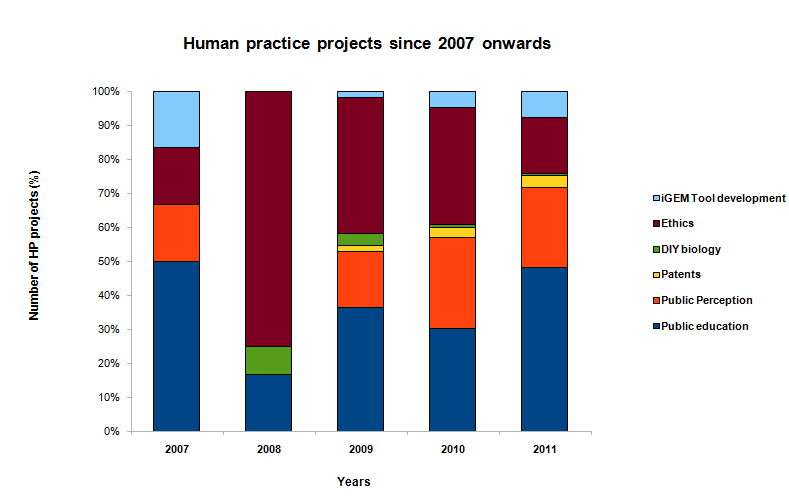Team:Paris Bettencourt/HumanPractice
From 2011.igem.org

Human Practice
Abstract
The grand scheme behind the Parisian Human Practice of this year is to synthetize questions and possibly answer some of the concerns or issues that previous iGEM might have had. While this exercize being done we expect that new questions/concerns might arise. Next, an outline of needs and responsibilities of either iGEMers, synthetic biologists or governmental bodies can be made. Using this final we hope to create a unified document: citizen and scientific proposal on synthetic biology.
The project
Introduction
Much like in the early times of Biotechnology scientists gathered and set for themselves some basic standards and practices on both ethical and pragmatic issues I believe that it is time we, iGEMers, as future researchers are entitled to have our word on how the field of synthetic biology (as well as the iGEM competition) ought to look like. Did you know that the President Obama asked last year for a report on bioethical issues regarding Synthetic Biology? The report came out in December 2010 and included a set of recommendations that the discussion panel deemed necessary. Good. Better yet: why not produce a more down-to-earth proposal on synthetic biology ?
As an interesting turn of fate 2012 happens to be the year in which both French and US Presidential elections are happening (and 2013 for the German ones), what if we could produce a unified document that could potentially change the face of how Science is done? Ambitious? Most probably BUT if we co-operate on European level such an aim is completely attainable. The first thing is to get the frame of analysis, have clear steps to follow if coordination is to happen.
Please find the outline I propose for the co-operative project for an iGEM centered proposal on synthetic biology.
The more we are, the more questions we can tackle! While this si targeted primarily towards European teams because we are operating under common basis (European Union regulations) the debates are similar across the world therefore everybody is welcome
Step 1: Scanning of the wiki
We dedicated a good deal of time just to actually go into each wikis of each years since 2007 until 2010 and find what were the themes tackled by the teams. A priori, we told ourselves that obviously teams having a clear human practice tab were to be considered but as in the past iGEM competition it was not mandatory to include such discussion we thought that people might have included it within a more general discussion and this is why we read all of them. Everytime there was a discussion about bio-safety/bio-security ethics or any kind of reflexion revolving around synthetic biology up to the application of the project was taken into account. The primary raw data was huge, but we already had quite an overview of what had been said. This is where we agreed between us to discard discussion on applications of a project since most teams where mentionning it. Second, we created six convenient categories that are as follows:
- Public education
- This includes bringing to the public (defined as other iGEM teams, scientists or the general public) a presentation of what is synthetic biology (SB) or the specific iGEM project may it be in the form of a forum, a conference or classes given to students.
- Public perception
- This includes getting to know the opinion or the preconception of what is SB, genetic modifications of organims and any relevant pieces of information about their knowledge in biology/modelling/engineering. We also included in that part the social and political framework in which iGEM evolves.
- Patents and licenses
- This is a rather specific discussion or questioning about laws, patenting regulations and other legal concerns.
- DIY bio
- The Do It Yourself (DIY) movement is at the cross-section of many societal and scientific debates therefore it is a section in and of itself.
- Ethics
- This is the most vague section as it includes bio-safety, bio-security issues as well as questioning about application and societal implications of iGEM and biology at large. As a matter of fact any thorough investigations and questioning revolving around SB was included here.
- iGEM tool development
- Some teams decided to give back to the SB's community in another form than BioBricks, some of them developed "how-to" guides and others software programs.
Analysis of Data Scanned
This way of regrouping common questions, common practices mentioned by the past teams allows for some basic statistical analysis. What we present here is mostly for descriptive purposes. The first trend that we observe is an obvious augmentation of human practice (HP) projects, both in terms of absolute numbers and relatively to the number of iGEM projects, over the years.
Second, we have this other simple bar graph that is an overview of the data obtained from the scan. It gives the relative amount of each kind of category. Interestingly, "Ethics" with 38% of teams treating it has been the most widely discussed theme. Right after comes "Public Education" (32%) and "Public Perception" (21%). The three remaining themes account for the rest (9%). It must be noted that we might at some point considered two different themes for a single team if their projects covered them so this makes a greater total number of themes than human practice projects per se.
The graph below shows the percentage of each category of human practice project in each year of the iGEM competition. As observed, a greater number of teams that worked on human practice project in the beginning (2007;deep blue bands) focused on educating the public on the new field of synthetic biology. This has however decreased recently in 2010 since synthetic biology is growing in the community and the awareness is increasing. Now that synthetic biology has become known to the public, the next hurdle is to look at the perception of the public (orange colour) on the field and this attributes to why an increase in human practice projects centred on public perception is observed in recent iGEM human practice projects. Secondly, Patents have become a great issue in synthetic biology as the idea is to create a standardised and reusable open source parts. The issue of patents in an iGEM project discovery and synthetic biology in general has called for an increase in the number of human practise projects addressing this recently (yellow bands). Ethical concerns (pink colour) were raised after the first iGEM competition (2007) on the potential dangers of synthetic biology and this called for a greater number of teams to focus on it in the next year (2008) as shown on the graph. Ethics still remains a major concern of synthetic biology and has since been addressed by the next generations of iGEM teams (2009-2010) although not as in the second iGEM competition. There were quite a low number of Do It Yourself biology (DIY) (green colour) issues addressed by the iGEM teams and this trend was also observed in teams that tried to develop tools (sea blue) (software, manual guides etc.). Some of the trends observed can also be attributed to the increase in diversity of the human practice projects as more teams tend to address different issues of synthetic biology in their projects.
Analysis of the Grenoble Video
The team from Grenoble made a video of a debate on synthetic biology that they sent to us as part of our Human practice project. They had read the cooperative project proposal and decided to focus on a more ethical point of view. This kind of video provides a unique insight into what non-SBist think of the field.
The way they created the discussion allows people to express themselves and also to stir up substantive issues together. From their video, we highlighted three major issues: firstly, what means synthetic biology and what are the thoughts in terms of dream and fable? Secondly, what could be the main ethical issues? And finally how the future of such a field could take shape?
In the assembly, we saw two kind of personalities: on the one hand those that set out the idea of a technological tool that has practical applications and which is dedicated to commercial use. On the other hand people looking for any convincing arguments on the usefulness of SB. It clearly appears here that these people ask for more clarifications from scientists and companies. One of the fable behind could be the will of the synthetic biology cosmos to hide the truth in order to avoid any mass panic, as it happened with GMOs in France.
From the ethical point of view, two notions are underlined: the first of which is the scientists' responsibilities. Is the field too young insomuch, we scientists, fail analyzing it by taking a step back? Do we have enough credibility (And who would decide anyways? Politics, firms or scientists?)?
The last issue that was raised during the debate was: if there are commercial interests, how to avoid propagation of GMOs? Any scientist really has to dwell upon notions of capacity to live outside the lab, control and analysis of external factors. It is true, for instance, that if a commercial synthetic biological products was to be used by the general public there would be a clear concern of proper usage and proper recycling. This point allows me to dress up the second notion which is: do we have to put one's head on the block and what are the risks?
The final point raised was: we (as scientists) chose to work on synthetic biology because we have a lot of expectations but what about a renovation of the SB movement? Or should it continue as it is? And who would decide for us?
We find that, in the end, their debate revolved around the essence of SB whether it is a tool or a proper scientific field. This question brings about all the issues of decision processes and risks versus benefits assessment.
Step 2: Synthetise information and spark debates
Once the data retrieved and some information obtained on the nature of the themes and some knowledge about the questions treated we started to get interested in the patents matter. We decided not to treat ethics any further since we had the Grenoble debate video. The theme patents has been treated four times only which is surprising since it seems to be a crucial theme for the good progress of iGEM projects in an open-source manner. It must be noted that the following text may not represent the profound opinion and beliefs of all the members of the team, however it created a sort of consensus when we debated. The debates were hold on non-official basis but the whole team participated.
On the matter of patents and patentability
Through the scanning of previous wikis, it was noticed that a theme, albeit central to biology nowadays, had been treated only twice. It ought to be mentioned that there is no need for an extensive survey of the literature to get a grasp of what the issue revolves around. Conceptually, it is mostly an opposition of private versus public good or reward versus exclusivity. Here, I present a view that is clearly from the narrow point of view of students in research and participants in the iGEM competition.
The process in and of itself had been created to reward an inventor by allowing him exclusive economic benefits for usually twenty years. The European criterion is as follows:
Art. 52(1): ” European patents are granted for inventions that are new, involve an inventive step and are susceptible of industrial application. An invention can belong to any field of technology » 1
This is quite vague and probably inadequate as we will see later. From my understanding, in regards to patentability of the living, treatment methods on animals and humans are not patentable while the molecules used are. Naturally occurring organisms are also excluded. However, and this is where it is most relevant to us is the point about microorganisms:
Guid. C-IV, 4.7 : The exclusion does not apply to microbiological processes or the products of such processes. In general, biotechnological inventions are also patentable if they concern biological material that is isolated from its natural environment or produced by means of a technical process, even if it previously occurred in nature.1
Our experience during the competition has been one of open-source: many researcher have kindly shared their strains and their technical knowledge when applicable, most notably the authors of the article we are basing our study on. To be added is the offer of the “push-on push-off” system put together by the PKU team. “Why can't it always be this way?”, I ask myself naively. The immediate answer that was given to me by some non-biologists was that we were working at the fundamental level, with no real big money in play. In effect, bearing in mind [http://parts.mit.edu/igem07/index.php/BerkiGEM2007Present6 2007 Berkeley_UC]'s example, the questions of patents poses itself, at our level at least, if a clear application is the outcome of an iGEM project. That lead to think about this issue, although we did not hit a dead end by confronting any patents. The main belief that I now have is that: genomes should not be patented whatever the organisms.
Research first!
That is the main point I want to focus on, indeed as future researcher we are maybe going to be confronted with patent issues. I see no reason why any form of retention should come up in research even if patented material is used. It seems that usually University researchers do not encounter such difficulty 4, however in a preventive manner it should made explicit in biotechnology patents that every bit of information concerning the “invention” should be made public, freely available and threat of going to court forbidden. This is just extending the Synthetic Biology principles already exposed by Jimmy Huan of the 2008 UCSF team but applying them to the whole Living and all genomes. This open source approach in essence makes a common database of genes accessible to all researchers worldwide.
Noteworthy: I am not condemning patenting, it is a perfect way to reward an inventor (a finder more like in the context of biotechnology) for its ingenuity and hard work. However, it must not impinge on further research so, in a way similar to the BioBrick legal situation, all DNA must be open-sourced even though a particular application may be patented. In my opinion, this would be putting into practice one of the ideals of synthetic biology.
A possible solution that I foresee is to be able to patent only the final product of the genetic circuit may it be a function, a medicinal molecule etc. if and only if it has the previous requirements of general patentability.
Pragmatic approach needed
Not even considering religious issues, how can one really claim to make someting new if it is just “discovering” something that existed? The term discovering is used sarcastically since on a conceptual level even if one made a modified antibiotic or whatever he still started with the existing genetic sequence and worked in such a way that one induced a conformational change in a protein that so happened to be beneficial. This point is very debatable but nonetheless patents are useful to get the credit for one's research and efforts. Taking an example of the possible absurdity of the application of patents and the distribution thereof is given by the European Office of Patents 3 : there exist a practice that consists of collecting, characterizing and then use exotic plants to create novel drugs even though the properties of it were known for centuries. Bio-piracy 6, as it is called, aims at patenting genes that have an obvious function but have not yet been characterized and hence are patentable. This practice is unacceptable because the population that were cultivating it might just have to pay the pharmaceutical firm to get the exact same product. I believe that once again if genes were removed out of exclusivity then no problems would arise. The said firm would have to use faire techniques to compete against the local production: such as proposing cheaper drugs. In the envisaged solution (final product only equals possible patentability) only the final molecules would be patented under this conditional name: molecules "X, Y" coming from a "W" enhanced genetic circuit in microorganism "Z". Under this condition, no genes could be patented, the plant genome's or the respective sequenced part available without trade secret, research could ensue and the country could still naturally produce it's plant and use it in a traditional way may the economic incentive to do so be there.
Sources
1) European Guide For Patent Application [http://www.epo.org/applying/european/Guide-for-applicants.html]
2) Biotechnology in European patents - threat or promise? [http://www.epo.org/news-issues/issues/biotechnology.html]
3) India’s Traditional Knowledge Digital Library (TKDL): A powerful tool for patent examiners [http://www.epo.org/news-issues/issues/traditional.html]
4) Can patents deter innovation, the anticommons in biomedical research. M.A. Heller . Science 280. 1998 [http://www.sciencemag.org/content/280/5364/698.full?searchid=1&HITS=10&hits=10&resourcetype=HWCIT&maxtoshow=&RESULTFORMAT=&FIRSTINDEX=0&fulltext=michael%20heller]
5) Gene Patents, in From Birth to Death and Bench to clinic: The Hasting Center Bioethics Briefing Book for Journalists, Policymakers and Campaigns. R. Cook-Deegan [http://www.google.fr/url?sa=t&source=web&cd=2&ved=0CCMQFjAB&url=http%3A%2F%2Fwww.thehastingscenter.org%2FuploadedFiles%2FPublications%2FBriefing_Book%2Fgene%2520patents%2520chapter.pdf&rct=j&q=Gene%20Patents%2C%20in%20From%20Birth%20to%20Death%20and%20Bench%20to%20clinic%3A%20The%20Hasting%20Center%20Bioethics%20Briefing%20Book%20for%20Journalists%2C%20Policymakers%20and%20Campaigns&ei=rj12Tve0J6HW0QX9h82YCA&usg=AFQjCNHdE2ns1fmKhHj4A3J12dnjL25ZIA&cad=rja]
6) Biopiracy: The Legal Perspective. M.A. Gollin [http://www.actionbioscience.org/biodiversity/gollin.html]
 "
"



